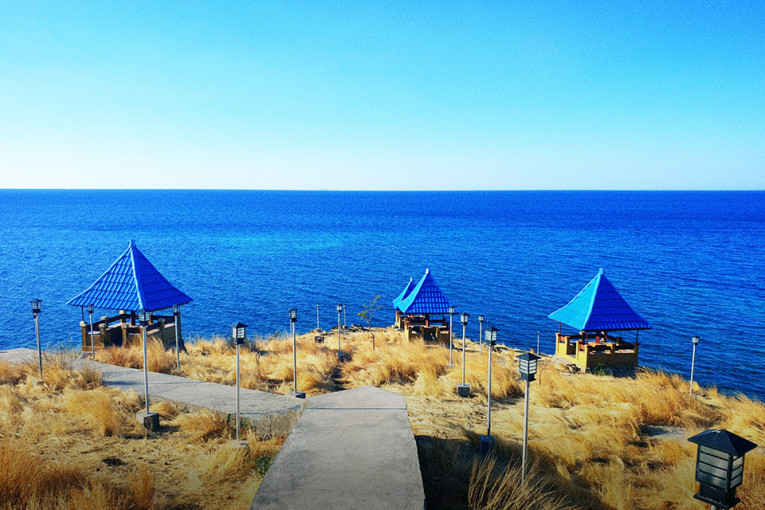
Tourism is emerging as a vital sector for boosting community income and increasing the Gross Regional Domestic Product (GRDP) of Sikka Regency, East Nusa Tenggara.
One strategy Sikka must pursue is developing its tourism sector to progress and catch up with other regions.
This was highlighted during the Final Exposure of the Review Document for the Sikka Regency Tourism Development Master Plan, a collaboration between the Regional Planning, Research, and Innovation Agency (Bapperida) of Sikka Regency and the UGM Center for Tourism Studies (Puspar UGM), held on Tuesday (Aug. 6) at the Bapperida Hall, Sikka Regency Government.
The event was attended by Acting Secretary of Sikka Regency Margaretha Movaldes Da Maga Bapa, Head of Bappeda, Head of the Department of Tourism and Culture, UPTD-KPH Sikka Regency, academics from several universities in Maumere City, Sikka Tourism Association PHRI, ASITA, HPI, AKUSIKA.
Representatives from Sanggar Budaya Lepo Lorun, Bliran Sina, and Doka Tawa Tana, as well as village heads, were also present. Dr. Destha Titi Raharjana and Ika Racmadhani Kurniawan represented the Puspar UGM expert team.
Acting Secretary of Sikka Regency Margaretha Movaldes Da Maga Bapa stated that Sikka Regency has a wide variety of tourist destinations that, if well-managed and developed, could stimulate growth in related sectors such as infrastructure, agriculture, food, creative industries, transportation, and other services.
“With various tourism activities, there will certainly be many new business opportunities and increased income for the local community,” she said on behalf of the Acting Regent of Sikka.
On this occasion, the secretary also strongly desired that UGM send its students for Community Service Programs (KKN) in the Sikka Regency. She said these KKN UGM activities could accelerate development in the Sikka Regency.
“We hope that through this collaboration, there will be a transfer of knowledge from UGM to local universities in Sikka Regency. Collaboration between universities, such as UGM with local campuses in Sikka, should be encouraged, and with this collaboration, joint research can certainly be conducted,” she said.
Puspar UGM expert team member Dr. Destha Titi Raharjana mentioned that Sikka Regency can potentially retain tourists for extended stays due to its diverse, natural, cultural, and scenic attractions.
“Unfortunately, it still faces several challenges in marketing,” Dr. Raharjana noted.
The challenges include limited air transportation options. Flight schedules to and from Sikka are not guaranteed daily.
“Flights still depend on Labuan Bajo-West Manggarai,” Dr. Raharjana explained.
The second challenge is the long travel time required to reach Sikka. Third, from a promotional perspective, especially through the POSE (Paid Media, Owned Media, Social Media, and Endorse) approach, there is still a lack of serious effort and adequate facilities.
Moreover, there is a shortage of innovative human resources, and budget constraints limit this effort.
“Fourth, although information technology is being utilized for marketing, the updating and packaging of promotions have not been extensively carried out,” Dr. Raharjana added.
Another researcher, Wijaya, presented Puspar UGM’s analysis of tourism attractions, identifying 126 attractions spread across 21 districts. Waigete District has the most attractions, with 12, followed by Palue, East Alok, and Magepanda Districts, each with ten attractions.
The districts with the fewest attractions are Mapitara and Koting, with just one attraction each. Natural attractions comprise the majority, with 73; cultural attractions with 47; and man-made attractions with 6.
“Among the 126 attractions, ten are considered top-tier attractions based on tourism appeal criteria,” he said.
Wijaya mentioned several potential tourist sites, including Koja Doi Island, Mini Beach, Bukit Purba, Jembatan Batu, Pangabatang Island, Koka Beach, Bliran Sina Cultural Studio, Lepo Lorun Cultural Studio, Kajuwulu Cape, Egon Nature Tourism, Babi Island, Doka Tana Tawa Cultural Studio, and Paga Beach.
Meanwhile, Ika Racmadhani Kurniawan, a research assistant at Puspar UGM, added that the territorial tourism analysis conducted by Puspar UGM proposed four Regency Tourism Destinations (DPK), three Regency Tourism Development Areas (KPPK), and seven Strategic Tourism Areas (KSPK).
The seven KSPK in Sikka include KSPK 1 Maumere Bay Marine Tourism Park (TWAL) and surrounding areas, KSPK 2 Kajuwulu-Magepanda and surrounding areas, KSPK 3 Maumere City and surrounding areas, KSPK 4 Egon-Blidit and surrounding areas, KSPK 5 Nita-Nelle and surrounding areas, KSPK 6 Kojowair-Umauta and surrounding areas, and KSPK 7 Koka-Paga and surrounding areas.
Dominggus, a local tourism practitioner, acknowledged Sikka Regency’s diverse potential but noted that it has not yet been able to compete with other destinations.
He believes it is difficult for Sikka to compete with Labuan Bajo because it is a super-premium destination that receives significant government funding.
“The large-scale infrastructure-based tourism development in Labuan Bajo has marginalized the local culture. Therefore, we strive to make Sikka the antithesis of Labuan Bajo by emphasizing culture as the strength neighboring regencies lack,” Dominggus hoped.
The Head of the Regional Research and Innovation Division of Bapperida Sikka Regency, Fransiskus Suryanto Nara Bata, stated that tourism development in Sikka Regency has been prioritized over the past two years.
This is reflected in the regional development planning documents. Support from the local government in the tourism sector has begun to show, with large-scale tourism and cultural events, such as the Jelajah Maumere Festival, scheduled for Sep. 12-14.
“One of the most interesting activities at the festival will be the Sikka Fashion Carnival (SFK), which will highlight ikat weaving as a cultural strength of Sikka,” said the division head.
Author: Agung Nugroho
Photo: Superlive.id
Post-editor: Afif

